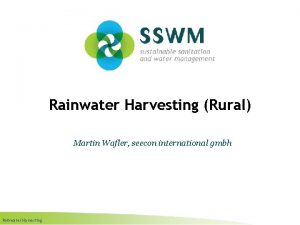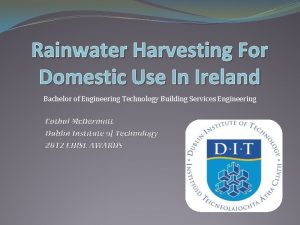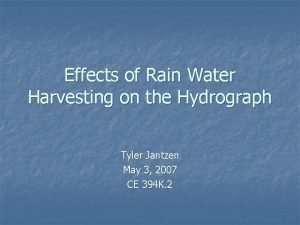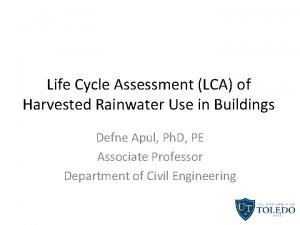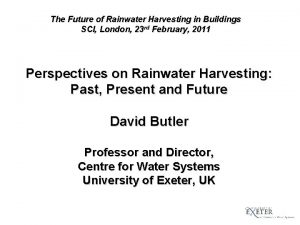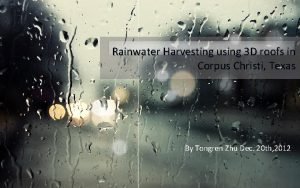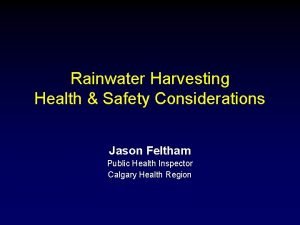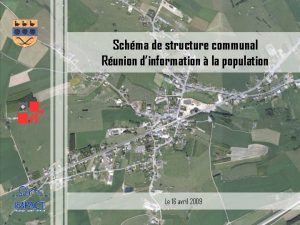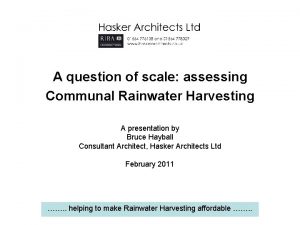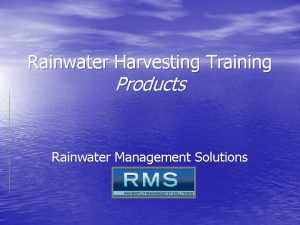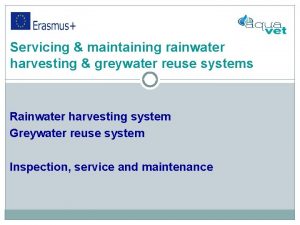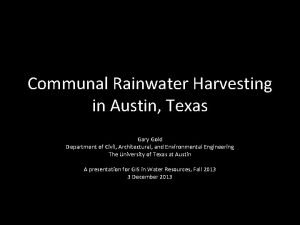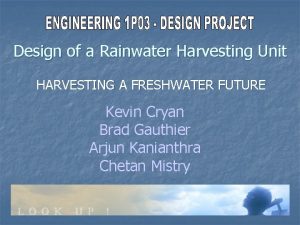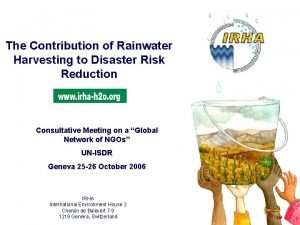A question of scale assessing Communal Rainwater Harvesting















- Slides: 15

A question of scale: assessing Communal Rainwater Harvesting A presentation by Bruce Hayball Consultant Architect, Hasker Architects Ltd February 2011 ……. . helping to make Rainwater Harvesting affordable ……. .

Introduction Good afternoon. • Architect • Housing design experience • Rainwater harvesting (RWH) experience >>

Why is this subject of interest to an Architect? In 2006, I designed a scheme of 38 dwellings: • Site = basin + need to pump • Use RW for flushing = a sustainable idea • But, can anyone guess what the developer's reaction was? >> – "We don't have to do this, so, guess what. . ? " I began to think that here is a problem needing a creative solution. . . >>

The Exeter presentation Focussed on: • • • The scale of the market Obstacles to delivery Where will the money come from? How will housing developers be motivated? Solutions, including: – Scales and thresholds – Charging for grade B water through communal RWH & GWR >> Today, my focus will be on: • • • Dangers Needs – Clarity on market size – Maintenance – Training How do we get to robust solutions? >>

Personal RWH experience 1960 – 1980: parents lived in a property with RWH >> 3 properties built in 1930 s, each one had a similar tank >> Today, all of the first floor tanks have been removed Abandonment is a huge issue >>

Scaling up the RWH market My new homes forecast x implementation x £ per home can be expressed as follows 40 x today’s £ by 2020 10 x today’s £ by 2016 In addition: by 2020, maintenance could add 25% to this annual market. >> See Exeter presentation for more detail (link at end). >>

Cart or horse? Training needed for: • • • Installers Developers Designers Planners Green infrastructure funders >> But we shouldn’t even start to train people until the formula is right!! Otherwise we are off on the wrong foot. >> We probably are already? ? !! >>

Implementation scale No of dwellings Type of installation Adoption? 1 – X (10? ? ) Individual RWH &/or GWR No X – Y (1, 000? ? ) Communal RWH &/or GWR, possibly contributing to SUDS Maybe >Y Ditto, but with water cleaned up to potable standard for feeding into the mains water grid Definitely The thresholds values (X and Y) need to be determined. Expectation: X and Y will be site specific >>

We need an implementation programme For some sites, RWH / GWR is already being mandated through local Water Management SPDs and through land purchase conditions. >>

Dangers and issues 1. 2. 3. 4. 5. Lack of maintenance >> Abandonment >> Cross contamination >> Ability to find a willing and trained plumber >> Where will the money come from? >> To deliver a sustained pattern of water efficiency in the long term, we need to address these key dangers and issues. >> If we can get it right for new build, we can then roll it out more confidently for retrofit. >>

Getting it right The UK needs to invest NOW in appropriate research for RWH and GWR, to determine long-term, sustainable and cost-effective solutions. >> RWH & GWR are already out of the starting blocks!! So let’s get it right from hereon in!! >> By 2020, let’s avoid wasting £ 1, 800 m >> That’s 2. 5 of these !!!!!! ……. .

Conclusions from the Exeter presentation • If we do nothing, developers will be faced with having to spend £ 1, 500 - £ 3, 500* per dwelling ( or £ 4, 500* if you include greywater recycling ) to achieve the water efficiency targets under the Cf. SH levels 5 and 6. – Where will this money come from? >> • On a site we are designing, the developer could be faced with spending £ 3 k £ 7 k* on engineer’s fees just to prove to the Planners whether we need to provide this kit or not. • With that money, the kit could have been installed!! • Some common sense is needed here to cut out the chaff and focus thinking and expenditure on the essential, desired and sustainable outcomes. • Developers are not in business to undertake a personal philosophical journey on every development, or even on one. There is equally little benefit in the 353 local Planning Authorities in England undertaking a similar detailed checking exercise on every planning application. – • Where will the money for all these fees come from? >> Where is the freely available information that Architects, Engineers, Planners and Developers need to make consistent and properly informed decisions on this subject? >> *Sources for costs: Davis Langdon, Hasker Architects

Conclusions……………. continued • How can water companies properly plan for future water demand outflows? • My expectation is that selling grade B water would create a revenue stream that could cover the maintenance cost and part of the capital cost. • For some sites, we might get the capital cost down to £ 500 per dwelling (who knows; that’s why we need the research). But, this is a funding deficit. Wherever the site is, and whatever the constraints, there is always likely to be a funding deficit. • That money may have to come from the government, landowners, water companies, or householders. • But additional water infrastructure capacity is still needed, and additional sewerage infrastructure may also be needed. Future infrastructure charges to developers will need to be appropriate to what is provided on site, and be charged correctly to consumers from the outset. Independent certification should be provided by Building Inspectors. • Decision-makers already have information overload, and yet: concise, freely available, mature information on this subject is conspicuous by it’s absence. • Much more research needs to be done, and soon. >>

A question of scale: assessing Communal Rainwater Harvesting • Thanks for listening. • If you would like to look at the full version of my Exeter presentation, this is available to download (see link on next / last page). • Any immediate questions? A presentation by: Bruce Hayball, Consultant Architect, Hasker Architects Ltd February 2011 Tel: 01564 778029 Email: brucehayball@haskerarchitects. co. uk

A question of scale: assessing Communal Rainwater Harvesting For anyone interested, copies of our Research Scoping Document are available on request. Handouts from the Exeter and London workshops are available online, at: http: //centres. exeter. ac. uk/cws/downloads/cat_view/68 -rainwater-harvesting-events Please come and talk to us about funding the necessary research!! ……. . helping to make Rainwater Harvesting affordable, with ……. .
 Conclusion of rain water harvesting
Conclusion of rain water harvesting Function of rainwater harvesting
Function of rainwater harvesting Corkglass
Corkglass Domestic rainwater harvesting
Domestic rainwater harvesting What is rainwater harvesting
What is rainwater harvesting Life cycle assessment of rainwater harvesting
Life cycle assessment of rainwater harvesting Bibliography of rainwater harvesting
Bibliography of rainwater harvesting Coarse mesh in rainwater harvesting
Coarse mesh in rainwater harvesting Future of rainwater harvesting
Future of rainwater harvesting Conclusion of rain water harvesting
Conclusion of rain water harvesting Droofs
Droofs Rainwater harvesting introduction
Rainwater harvesting introduction Rainwater harvesting calgary
Rainwater harvesting calgary Level 3 question examples
Level 3 question examples Schéma de structure communal
Schéma de structure communal Nature is the best role model for communal harmony
Nature is the best role model for communal harmony

